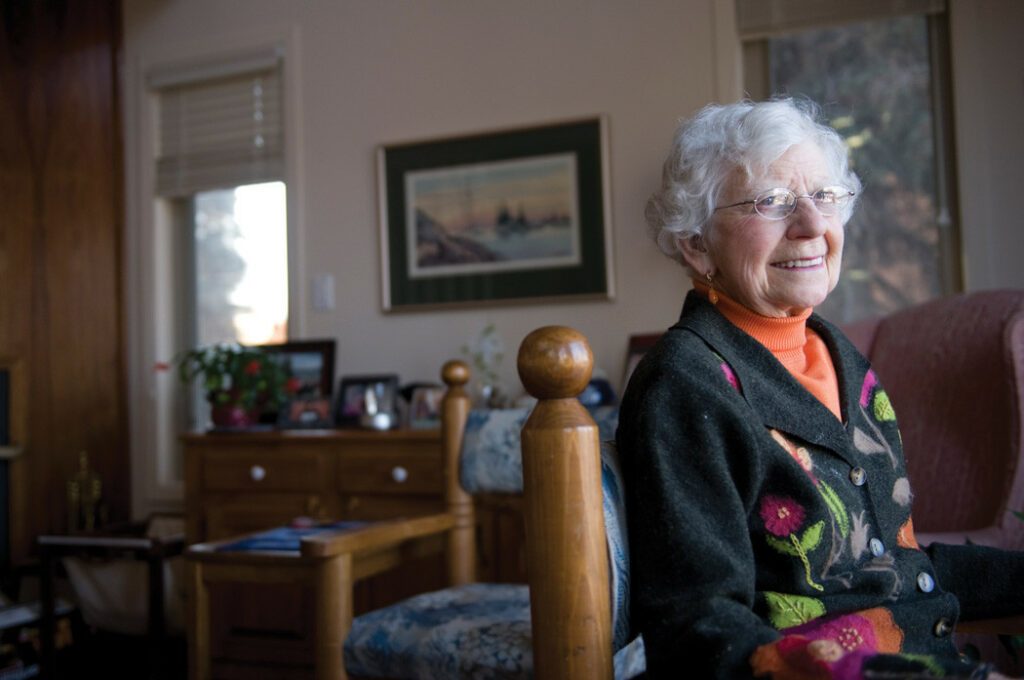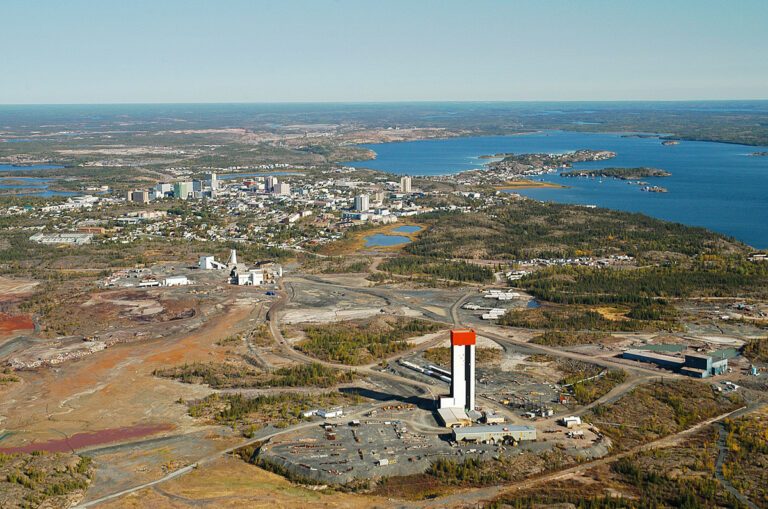by Lynda Comerford
Tea and cookies are spread out on a homey kitchen table on a Sunday afternoon. The sun pours in through a big window and the patio doors frame the antics of a zealous little squirrel. “I don’t want to move out of this house,” says Barb Bromley, “but I can see that it’s the best thing.”
This Morrison Drive house in Old Town has been her home for the last 38 years. She started Yellowknife’s first bed and breakfast here and operated it for about 18 years. Now the spacious three-storey hosts only her. And at 88 years – like many others her age – she finds it hard to manage on her own.
Even with a live-in caregiver, the house is still a challenge. That’s why she’s finally getting ready to move into an apartment, where she will continue with a caregiver. As we chat, she doesn’t seem to mind the idea. “I won’t have to climb stairs,” she says. “The apartment has elevators, and with everything on one floor, laundry access will be much easier.”
The matriarch of the long-time Yellowknife family comments that Avens Court is where she wanted to go. As a former public health nurse, she had a hand from day one in helping to develop the current Avens campus of facilities here in the city. She even has a wing of the dementia centre named after her. It’s ironic then, that in her time of need, she can’t get into the very facilities she helped to found. But she is not alone.
The demand for a range of housing options to accommodate Yellowknife’s growing seniors population far outstrips what’s available now, and over the coming decade, it’s expected to skyrocket. That’s something Avens’ CEO Jeff Renaud finds disturbing. “I’m not sure people in the NWT recognize the seriousness of the shortcomings of our supportive housing infrastructure,” Renaud says. “Our community is in crisis, and in the two years I’ve been here, it’s gotten worse.”
According to the most recent census reports, the number of seniors over 75 years of age in the NWT is projected to increase by 125 per cent over the next 12 years. In that same timeframe, the projected number in Yellowknife is set to increase by over 300 per cent. If the population growth trends for seniors continue, the requirement for long-term care beds could exceed 400 over the next 12 years. The current number of beds in the NWT is 173.
Barb’s son Bob Bromley, who is also the MLA for Weledeh, notes that when his mother was able to live comfortably in the independent living suites at Avens Court, she did not qualify, as she did not meet the low income criteria. “There are many people out there who are willing and able to pay more to live there, but it’s not an option,” he says. “If they don’t meet the low income criteria, there’s no room for them.”
In the absence of a suitable assisted care facility, families have to come up with their own solutions. “There are quite a few people being looked after by their families, either directly or indirectly in ways such as bringing meals or hiring live-in caregivers,” says Bob Bromley. This includes homecare, which according to him, offers an extraordinary level of service in Yellowknife. “The government is working hard to bump up homecare, and keeping seniors healthy at home, but I think we’re falling behind.”
“Aging in place”
He is referring to what is typically called “aging in place” – the latest buzz-phrase in seniors’ healthcare. It means being able to comfortably continue living in your home for as long as possible – rather than in a hospital or other
care facility.
Here in Yellowknife, we are fortunate to have Avens – A Community for Seniors. It boasts one long-term care facility (Aven Manor), one dementia centre (Aven Cottages) and two independent housing complexes (Aven Court and Aven Ridge). Currently, about 40 per cent of the residents in Aven Manor and Aven Cottages are from across the territory.
Unfortunately, the entire campus only houses 90 people at different stages of health and independence. So what happens to someone who can’t be at home by themselves anymore because of severe illness or a physical limitation? What if they have a terminal illness? Where can they go for quality end of life care? Where can they go when their spouse or family members can’t look after them anymore?
Right now in Yellowknife, the options are homecare, pay for private help or end up in extended care at Stanton Territorial Hospital. And while the hospital does an admirable job in these circumstances, it is not the ideal setting for long-term and palliative care, nor is it set up to deal with these in large numbers. According to Bob Bromley, the upcoming hospital renovation plans do not include any long-term care beds, typically known as extended care. The territorial government will need to replace those beds somewhere else.
Avens President Bill Braden says the current waiting list for any one of the 29 long-term care beds in Aven Manor stands at 19. These are doctor-certified individuals who have been recommended for the facility. Sometimes the wait can be six months. Sometimes it can be two years. In the meantime, many people are living in less than desirable or inappropriate circumstances, often with the other caregiver(s) wearing out.
Renaud, who is trained in gerontology and has worked in several major centres across Canada, says Yellowknife is lagging behind when it comes to addressing the housing needs of its elderly. “Some of these cities have amazing infrastructure for supporting seniors, right from the municipal to the federal levels,” he says. “In most other jurisdictions across Canada, seniors’ housing – including long-term care – is a shared responsibility between all levels of government. It is considered an essential service.”
Braden elaborates further, noting this is a global issue among developing countries due to the baby boomers. “Here in the NWT, we have more seniors that are going to hit that wall than the rest of Canada. We will need more specialized care,” he says. On top of that, more and more seniors are choosing to retire in Yellowknife, rather than move south.
To proactively meet this new reality, Avens is planning to expand and renovate its campus, pegged at a price tag of $27.5 million. Phase 1 will see the construction of a new 60-bed long-term care facility, to be called Aven Pavilion. Fifty-five beds will replace the 29 at Aven Manor and add 26 new multi-use beds. Also included in the facility will be three beds for palliative care, two beds for post-op recovery, family stay, etc., as well as space for rehabilitative programming (for things like stroke recovery and knee/hip replacements). It will also include a brand new kitchen with the capacity to serve 300 people.
Phase 2 is the renovation of the current Aven Manor structure to create 30 assisted living units (which is independent living, but with assistance for things like meals, taking medications and bathing).
Challenge is funding
“Avens has already invested half a million dollars of our own money to develop a business plan and a building plan,” says Braden. “We have the property, we have the space, we have the need and we have the staff.” What they are currently waiting for, is the territorial government to be firmly onside. “The GNWT recognizes the need and they know they have a large responsibility in this,” adds Braden. “The challenge is the funding.”
Avens is also pursuing partnerships in the private sector. While certainly a health care initiative, the planned construction is also an economic development project, with anywhere from 40-60 new jobs being created, as well as up to 40 jobs during construction.
Along with all three levels of government, Avens fundraisers are looking at partnerships across the board – from Aboriginal governments and organizations, foundations and service clubs to unions, commercial lenders, private families and individuals. The plan, according to Braden, is to find the funding and build as they go. While GNWT backing remains key, he points out that the government has contributed to helping individuals in need stay longer in their home communities. “The territorial government deserves some credit, as they are building regional facilities that all have some level of long-term care.”
But even with the new 60-bed Avens building, and two upcoming 18-bed facilities that the GNWT is constructing in Behchoko and Norman Wells, only about a quarter of the territories’ long-term care needs over the next 12 years will be addressed. Without investments now, waiting lists will grow, wait times will extend and our seniors will pay the price.
The need is urgent and growing for long-term care, but there’s also a need for the full continuum of care – from independent living, to assisted living, to long-term care and finally, palliative care. Everyone has a role to play in ensuring our elders and seniors have safe and comfortable living spaces, and Avens needs to be applauded for its foresight in trying to meet the growing demand for services.
As a Lifetime Director of Avens and the first president of YACCS (the group that preceded Avens), Barb Bromley continues to receive her meeting packages, although she may not make it out to many of the board meetings. At any rate, she’s looking forward to her move. “There’s an exercise room in the building,” she notes, “so I hope to get in there a lot.” A perfect activity to support aging in place.







